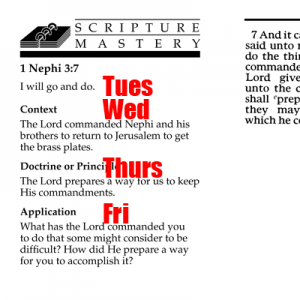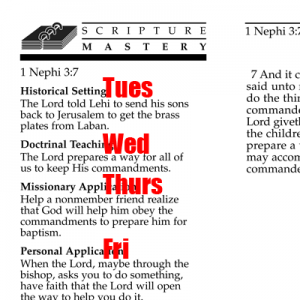
If you’re going to recite the passage as a class, you might as well read the additional information, too. If you do a different part each day, you’ll only add 30 seconds to your opening exercises.
I substituted for seminary this week, and I thought I’d pass along one small idea for anyone else out there who’s a seminary teacher or seminary class president or class member.
Many seminary classes have a scripture of the week—they pick one of the twenty-five scripture mastery passages and recite it together as a class during opening exercises (reading from a large-print poster or print-out posted on the board). They do this each class session, all five days of the school week, and then choose another passage for the following week. I’m guessing that most classes choose to do the passages in sequential order. It’s a great practice because by the end of the first twenty-five weeks of the school year, the class members have read aloud all the references and passages and have thus developed at least a basic familiarity with them.
My one additional suggestion is one that occurred to me when I was in high school. I think it was my junior year (Book of Mormon). Each scripture mastery card has additional information on it (Context, Doctrine or Principle, and Application. We decided to simply read one of those additional sections each morning before reciting aloud in unison the reference and passage. You can just go right down the card in the order printed:
- Monday—Just the reference and passage
- Tuesday—Key phrase, then reference and passage
- Wednesday—Context, then reference and passage
- Thursday—Doctrine or Principle, then reference and passage
- Friday—Application, then reference and passage
It’s simple, but it worked well. Feel free to tell us in the comments section below how it goes with your class, as well as any other ideas you’ve tried.

This is how we did it back in the day!
Just a boring historical side note: The old scripture mastery cards used to have four information sections: Historical Setting (now “Context”), Doctrinal Teaching (now “Doctrine or Principle”), Personal Application (now “Application”), and Missionary Application (now absent). I don’t know why they got rid of that last one, because I thought it was a great way of inculcating a share-the-gospel reflex. Maybe the missionary applications were too similar to the personal applications and thus redundant? Or maybe teachers on the ground were giving feedback that the unfortunate (and unnecessary) effect was that students were turning into proof-texters and Bible-bashers? I’d be curious to ask someone in the CES curriculum design department. I really like, though, how the new cards have added the Key Phrase.
Thanks for this great idea, Nathan.